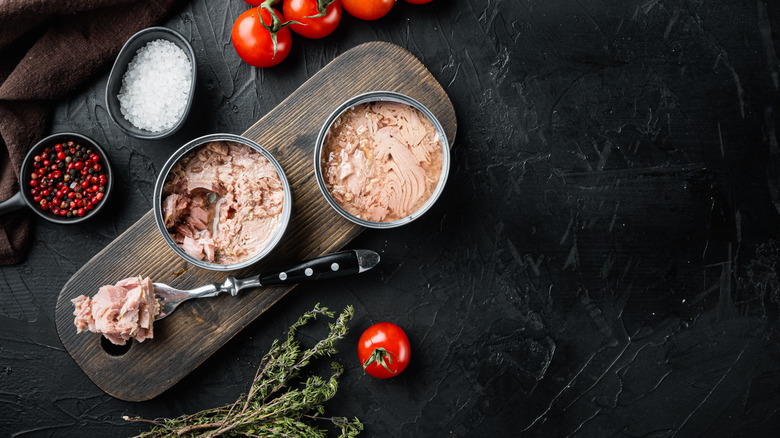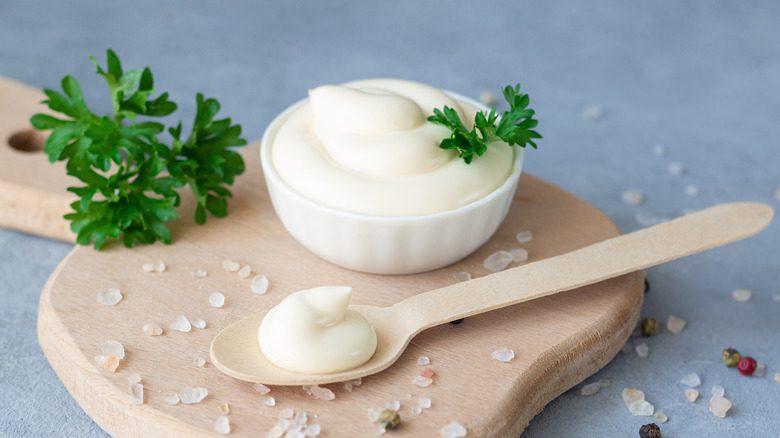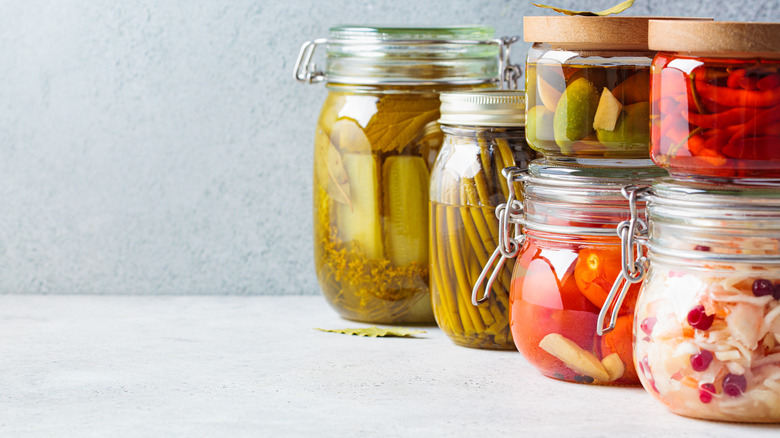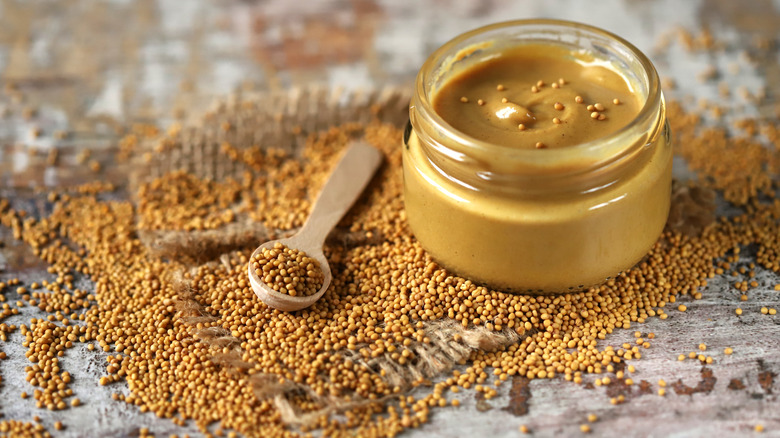The Absolute Best Additions To Canned Tuna
Whether you're jumping on the tinned fish craze or simply trying to burn through pandemic pantry purchases in a (let's face it) Instagrammable fashion, taking advantage of those uneaten cans of tuna clogging your cupboard is the perfect way to save money and give your stovetop some time off during the summer months. But since all tinned tunas aren't made equal, knowing how to fix up that preserved fish will elevate your picnics, sandwich fillings, tonnatos, and beyond.
Chances are there are plenty of items already lingering in the back of your fridge or scattered throughout your countertops just waiting to be put to good use. By mixing and matching complementary ingredients, your lonely cans of tuna will get the spa day they deserve before their moment in the spotlight; just remember not to crowd your pallet by pairing uncomplimentary or redundant flavors, and be mindful of how much fluids you're adding to the mixture so that the finished dish isn't (literally) drowning in liquid.
Of course, you'll want a sandwich filling to be sturdier than a spread or dip, but the main rule when building your dish is to trust your own taste and pick the ingredients that suit your palate or that of your guests if you're playing host. With that in mind, consider these accompaniments the next time you crack open a can of tuna.
Chop up some fresh herbs
Every protein has its favorite herby buddy. Steaks love the warmth of wintery rosemary, shrimp crave the bite of fresh cilantro, and, canned tuna (depending on the application) loves a little punch of parsley, a finish of fennel (preferable fresh), and a tinge of tarragon.
For summer-y sandwiches, the interplay between the brine of your tuna and the cooling bitterness of parsley makes for a clear, if not slightly obvious choice. The earthy quality of the herb brightens up the canned fish in recipes such as tuna lettuce wraps and masks any flaws the star attraction itself might have. Tarragon, a classic match with seafood, lends a hand if you're trying to construct a light-feeling, but ultimately filling dinner salad. The slightly floral quality of the herb will act as a bridge between the fish and any leafy, even bitter (like radicchio), greens you would use in a salad. If you're planning on creating a picnic-y pasta salad, the aromatic edge of fresh fennel will turn your simple can of tuna into a complex dish. We recommend (carefully) using a mandolin on a very fine setting along the rings of a bulb of fresh fennel. This will ensure that the fennel remains crisp but isn't overpowering in both texture and flavor presence throughout your dish.
But remembering to take the time to chop all of your herbs finely will ensure a cohesive, visually pleasing meal that will also sidestep any enormous and embarrassing flecks of greens in your (or your guest's) teeth.
Raid the pantry
We're applying the logic of the classic wine rule of "what grows together, goes together" to shopping from our own cabinets and calling it, "what's stored together is adored together." Hiding behind that embarrassingly large container of cornstarch are minor players that will add to your tuna-centric masterpiece.
Going back to the source of your hoarded tin will unlock the little flavors that your tuna needs to create a dimensional backbone. In particular, there are plenty of herbs and spices that will take your tuna salad up a notch. Of course, one should always salt to taste with nearly every dish that comes out of the kitchen, but beyond the punch of everyday kosher, we suggest reaching for your Bloody Mary's best friend, celery salt, and maybe even a little bit of lemon pepper to zest up your fish dish. For a garden-y element, try dried dill and marjoram either with or instead of fresh herbs.
However, we'd steer clear of any spices or dried ingredients that will suck moisture or freshness away from your dishes such as cumin, baking spices, and nutritional yeasts. Save those for earthier, heartier dishes. Similarly, we'd stay away from any sticky, clingy ingredients like tahini or nut butters as well as the grainy distraction of seeds and nuts in their natural state.
Spice things up
Don't wander too far away from your pantry, because a dash of heat not only makes your canned tuna dish perceived as richer on the palate, it also creates depth of flavor once you start incorporating acids a little later. Of course, there's the tried and true chili powder and flakes for a classic tuna sandwich but we're also in love with aleppo and urfa for dishes that slant toward Arabic-influenced cooking, like a tuna-studded tabouli or perhaps a tzatziki-inspired tuna and cucumber salad. Less overpowering than cumin, aleppo will give your tuna a leg up if you're wanting a bright tang and urfa brings an earthy, almost dried fruit quality to the table.
But possibly our favorite fiery flavor this summer is the Italian-oriented Calabrian chili that somehow articulates itself on the tongue as both smokey and fruity. Perfect for tuna dishes featuring tomatoes and other Catalonian ingredients, Calabrian chili powder enhances vitello tonnato and other dishes reliant on Italian flavors.
Add a squeeze of lemon juice
When dolling up canned or preserved foods, relying on simple, fresh ingredients will give your dish a leg-up. The tart quality of a healthy squirt of lemon is a welcome addition to virtually any seafood-centric dish, and that includes canned tuna. No matter the application, freshly squeezed lemon juice shouldn't be missing from the equation. Remember to utilize the zest of the citrus as well if you're reaching for an especially lemon-y flavor.
Defaulting to lemon feels almost as natural as reaching for a pinch of salt while stirring together any dish, but also consider using lime, especially if you're incorporating other ingredients that play off the slightly sharper flavor of the green fleshed-fruit. As a lax rule, we tend to pick up a lime if whipping up something Latin-inspired as well as any dish leaning on Asian spices or ingredients. Like its lemon counterpart, the zest of limes will add an extra pop that will take your canned tuna to the next level.
Take advantage of the produce aisle
If you want to give your canned tuna a flavor and texture boost, consider bringing in fresh produce. Sparingly and intentionally incorporated tomatoes are perfect if you're planning on a pita-encased sandwich or even if you're going the extra mile and pulling out a pan for a luxury tuna melt. The thick skins will contrast nicely with the fatty oily texture of tuna flesh — and don't forget to add a touch of tomato juice to the mixture as well.
Fresh alliums like red onion or shallot offer a pleasant bite of heat, especially with an Asian-influenced dish like a tuna-stuffed onigiri recipe. Tossing in bits of celery will add both a crunch and extra juiciness to your tuna creation. Whatever you decide to use, remember that the way you chop vegetables for tuna salad matters. Keep them into tight, tiny squares so they retain their texture and don't dissolve into your dish completely.
Keep it classic with mayonnaise
If in doubt, add mayonnaise! Unless you're averse to a creamy texture, the softness and fat of mayo will harmoniously marry the fatty and oily texture of the tinned fish. In fact, if you're looking to hide a less than ideal can of tuna's flaws such as tuna that wasn't canned in big, pleasurable chunks, the mayonnaise will create a cohesive character.
We highly suggest trying the extra-eggy Kewpie Mayonnaise, for an even more velvety mouthfeel. The chef-favorite Japanese condiment gives everyday snacks an extra boost since it's made entirely of egg yolks (no whites) and has a wink of a sweet tang thanks to rice or apple cider vinegar.
Whether you go kewpie or classic, mayo acts as a welcome guest for your canned tuna upgrade, especially to provide a textural contrast to the crunch of other additions such as shallots, onion, celery or fennel.
If mayo is a no-go, try sour cream or lebneh
If you're going for a zippy, herb-flecked dip to adorn chips or a crudités platter, opting for sour cream will provide that tart punch you're looking for, plus it's reliably versatile for any looser mixtures. Adding this ingredient slowly and conservatively will save you from going overboard and creating a too-wet texture to your dish that you'll have to fix later.
If you're going for a sturdier, thicker concoction, opting for labneh, a cousin to Greek yogurt and favorite for any Arabic-influenced mezze spreads, still provides a milky quality but with a little more structure for more of a spread or sandwich filling. Unlike sour cream, it's stiff enough that large, quenelle-like dollops of the creamy delight can dot a somewhat deconstructed tuna salad if you're looking to combine another element with your summery mixed greens. Both sour cream and labneh can easily take the place of mayonnaise if you're going for a creamier flavor.
Raise the temperature with hot sauce
Pulling out your favorite grocery store-purchased hot sauce and giving your canned tuna a dollop of heat will bring out the meaty, fatty qualities of the fish (think of the spicy mayo in a tuna roll at sushi). We suggest playing it safe and relying on vinegar-based hot sauces — think stalwarts like Tabasco, Frank's Red Hot, Valentina, or Crystal — since they will add both the spice you're looking for and also a little oomph from the vinegar. But if you're mixing up onigiri or perhaps a Japanese-style milk bread (or shokupan) sandwich with a spicy tuna filling, a restrained squirt of sriracha or other similar, thicker, more paste-like hot sauces will work too and lead your creations to an Asian flavor profile zone.
Just keep in mind that if you pinched and sprinkled some dry spices on your tuna, go ahead and skip the hot sauce. You don't want the fiery elements in your tuna dish battling for attention, or worse, overpowering everything else.
Vinegar offers a welcome tang
Balance is always the name of the game, even when cooking the simplest of snacks; so if you feel like your tuna is weighed down by thick, fatty flavors, spritz it up with a light, giving vinegar such as rice, sherry, or Champagne. Stay away from anything dark, thick, or inky like balsamic or Chinese black vinegar that could both overpower your dish with smokey, malty flavors and also dye the dish an off-putting beige color. Remember, you'd rarely (if ever) pair fish with red wine, and the same remains true with matching red wine vinegar with canned tuna. Keep it light, bright, and zippy so you don't risk drowning out the brine of the fish itself.
We suggest nixing this category if your tuna received a healthy amount of tanginess from a vinegar-based hot sauce. But if you're skipping that liquid heat, the sharp bite of vinegar will lighten up your tuna creation and give it a lively edge, especially when relying heavily on creamy add-ons like mayonnaise, sour cream, or labneh.
Add a pickle punch
Raid that side panel in your fridge and sift through anything pickled or preserved that could add some sweet, sour, salty, and crunchy depth to the tuna dish of your dreams. Dill pickles, olives, and capers are the first items that come to mind, but other brined accouterments like pickled red onions will also work.
Any whole pickle should be cut down to tiny pieces while olives can receive a rougher chop. Capers, however, are allowed to stay intact, mostly because the pickles are retaining the most liquid we want to be evenly distributed in the mixing process and not gradually, making your dish soggy as it sits. And if you restrained yourself from incorporating any vinegar options, tipping a dash of the pickling liquid into the tuna will both perk up the flavor profile and lend a hand if the mixture is looking a little stiff.
Don't forget the mustard
The king of the condiment shelf, mustard will be an obvious addition to any tuna sandwich. This team player can be used as a one-to-one mixture with mayonnaise or sour cream or sparingly to create a vinaigrette-like explosion on the palate.
Becoming familiar with popular types of mustard and what to do with them will keep your creation cohesive. As a rule, if you're using other ingredients that pack heat, steering away from any mustard that presents as hot, particularly varieties with a horseradish kick, or ones with whole mustard seeds is a safe idea. Similarly, if your dish already boasts an almost sweet, zingy quality, bypassing classic yellow mustard and moving to a more astute variation of the condiment will keep it from presenting too many clashing flavors. Keeping in mind ingredients that marry mustard well like parsley, shallot, lemon, tarragon, and dill will also clue you in on when to use this yellow wonder.











